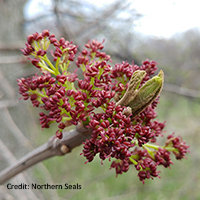What blue ash looks like
Size and shape
- Reaches 20 metres high.
- Trunk up to 25 centimetres in diameter.
Leaves
- Green leaves with 5 to 11 coarsely toothed leaflets (8 to 14 centimetres) on a central stalk.
Bark
- Grey and shaggy.
- Breaks into irregular, scaly plates with age.
Flowers
- Light green to purple.
- Grow in loose clusters.
- Bloom in mid-spring as leaves emerge.
Fruit
- Winged keys are light green and hairless when immature.
- Become tan to brown in fall when mature.
Where blue ash is found
Blue ash is an at risk species. Blue ash is confined to small patches north of Lake Erie and on the floodplains of the Thames and St. Clair rivers in Southwestern Ontario.
Find out what we are doing to protect blue ash by reading the recovery strategy.
What you need to know to grow blue ash
- Moisture: grows best in moist, well-drained soils.
- Soil: grows best in alkaline sandy loam but tolerates any soil acidity.
- Shade: grows best in full sun.
- Cautions:
- Emerald ash borer: an invasive insect that feeds on and kills ash trees. Signs of infection include wilted or yellow foliage, “D” shaped exit holes on tree bark and “S” shaped tunnels under the bark. Control measures for emerald ash borer include insecticide injections and restricting transport of infected ash supplies such as firewood.
Benefits and uses of blue ash
Wildlife benefits
Blue ash seeds are food for many mammals and birds, including:
- wood ducks
- wild turkeys
- beavers
- squirrels
Blue ash trees also provide browse for white-tailed deer.
Commercial uses
Blue ash is a hardwood that can be used to produce:
- flooring
- boxes and crates
- baseball bats
- tool handles
Fun facts about blue ash
- When exposed, the inner bark of blue ash turns blue, which is where it gets its name.
- Blue ash is easily distinguished from other ash trees by its four-angled twigs.
- Blue ash can live up to 150 years.
Updated: January 10, 2024
Published: October 21, 2014




